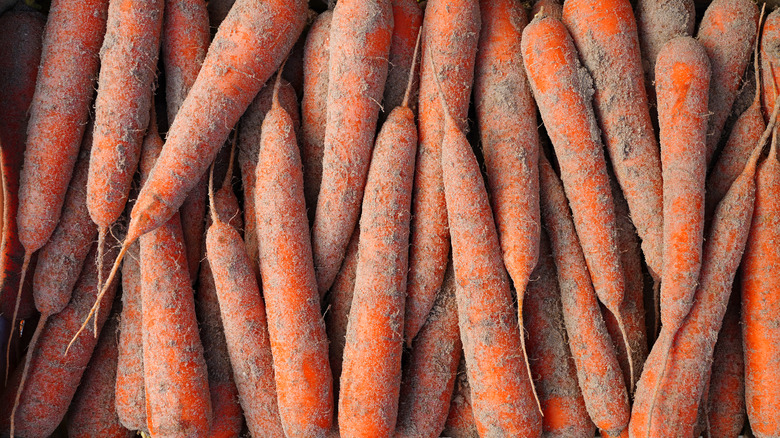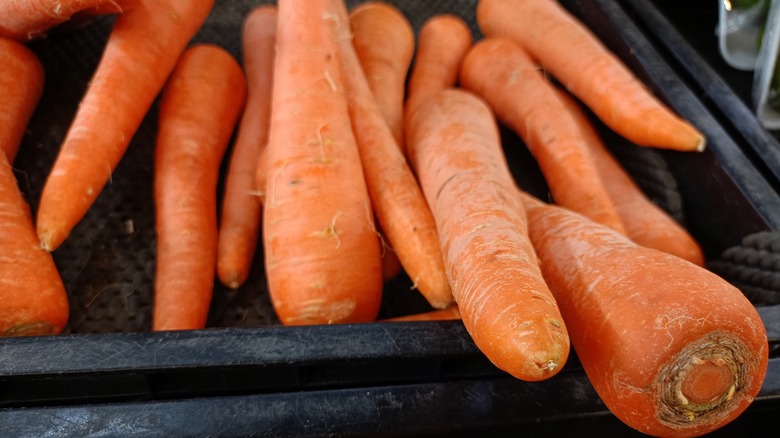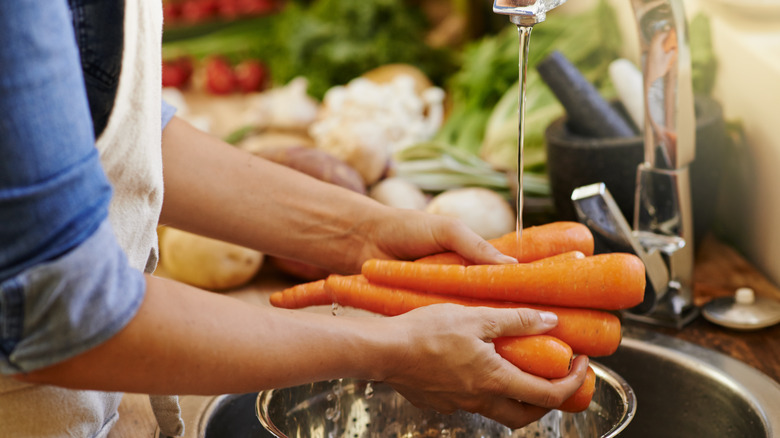The Odd Reason To Consider Storing Your Carrots In Sand
Sand isn't only great for putting your feet into at the beach. It also helps to store and preserve some vegetables like carrots, keeping them in their prime for a surprisingly long time. In case you didn't know, here's a fun fact about carrots: The root vegetable responds best to cool, dark storage spaces, and layers of sand can aid in providing these conditions. It's similar in practice to clamping; root clamps are underground vegetable storage spaces made by digging holes and layering veggies with hay or straw.
With sand, the material is traditionally used to keep vegetables through the winter, and it works because it helps to control humidity, preventing the veggies from rotting due to too much moisture — or drying out from too little. Properly done, this type of storage will keep your carrots fresh and ready to eat for as long as six months and will keep them crispy too. Veggies stored in a refrigerator, by contrast, remain edible for only three to four weeks.
The sand method isn't difficult to arrange, either. The only thing necessary is one or more containers and an appropriate place to store them. A specific type of sand is preferred, however: slightly damp play sand, a product commonly sold at home improvement stores in 50-pound bags.
How to store carrots in sand
Wooden or plastic crates as well as cardboard boxes are suitable for holding carrots in a layer of sand; this trick works for other root vegetables like beets, turnips, and ginger, too. Keeping the container in a cool place is essential though; ideally, a spot where the temperature is above freezing, but below 40 degrees Fahrenheit. High humidity is also preferred, making a basement or garage a good choice.
Before you start filling your containers, however, there is some basic prep work that needs to be done. Although it's not necessary to clean the carrots completely, caked dirt or soil should be brushed off, and the leafy tops (aka fronds or carrot greens) need to be removed. Also, eliminate any carrots that exhibit skin damage (nicks, gouges, and the like), as these are more prone to rotting; in storage, this rotting can spread to healthy specimens as well.
Leave out for at least two days of air exposure to help cure the skin, and then the carrots are ready to be loaded in their containers with sand. Start with at least a two-inch layer to line the bottom. As you start to layer in the veggies, make sure there is space between each one. Then completely cover with sand. Continue layering in this way until the box or crate has been filled.
Tips for cleaning carrots after a long storage period
It bears noting that, if you plan on storing lots of carrots, a container filled with sand can become very heavy and thus potentially problematic if it needs to be moved. Some people attempt to avoid these difficulties by keeping the containers on four-wheeled dollies, so they can be rolled if necessary. This solution serves another function, too, as boxes or crates should ideally be elevated off the ground during storage. So using a pallet or dedicated mobile dolly is recommended in all cases.
When you're ready to take them out of storage and begin cooking your carrots, make sure you clean them properly first. But wait until just before you're ready to cook them. To clean unpeeled carrots, use a scrub brush and warm water to remove dirt or sand. If peeled, a simple rinse under water should suffice. No soap or cleaner is needed, not even a dedicated produce wash; these items will not only alter the flavor of your carrots but may end up causing gastrointestinal distress as well if they're not carefully washed away and become accidentally ingested.



